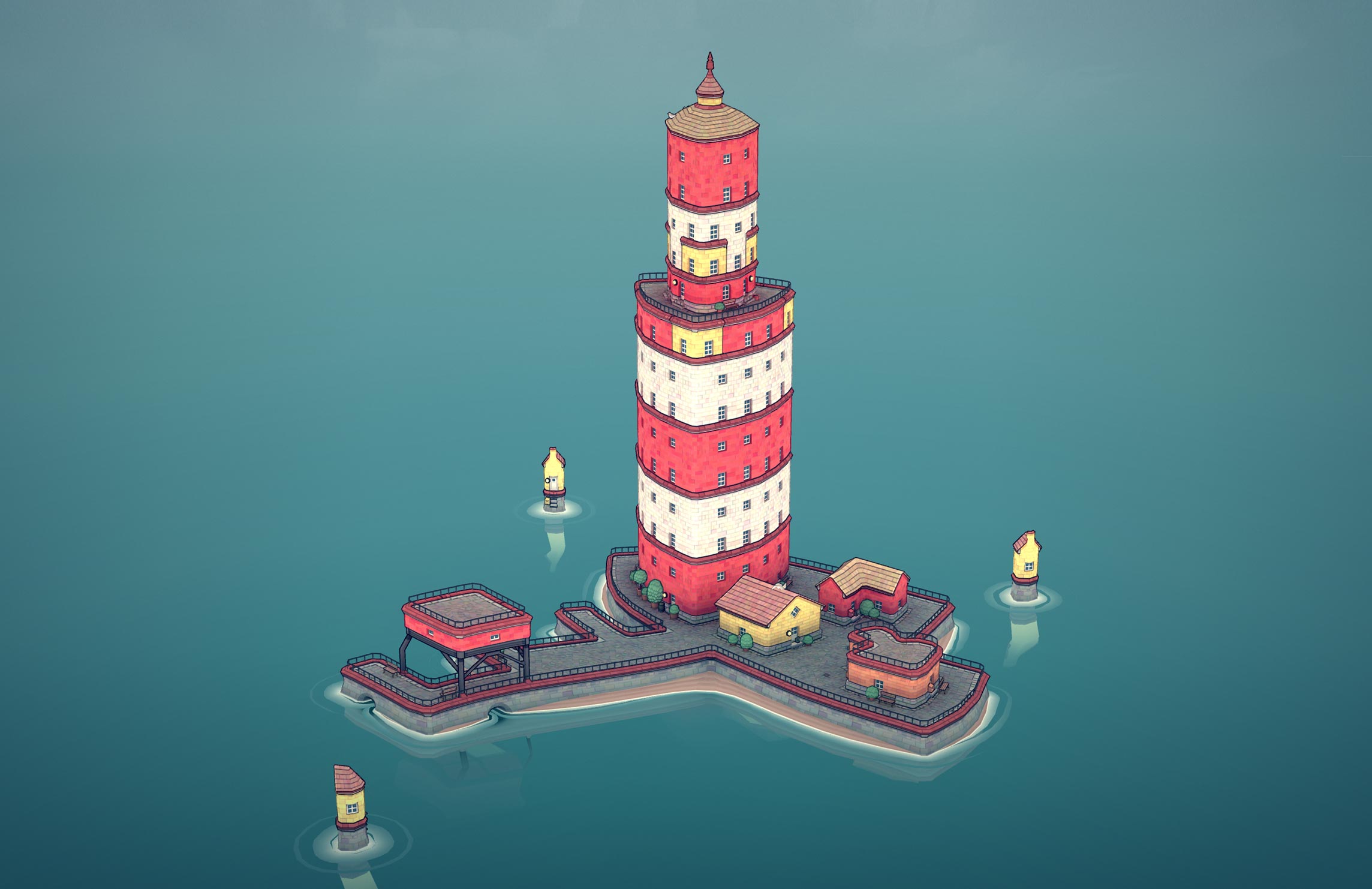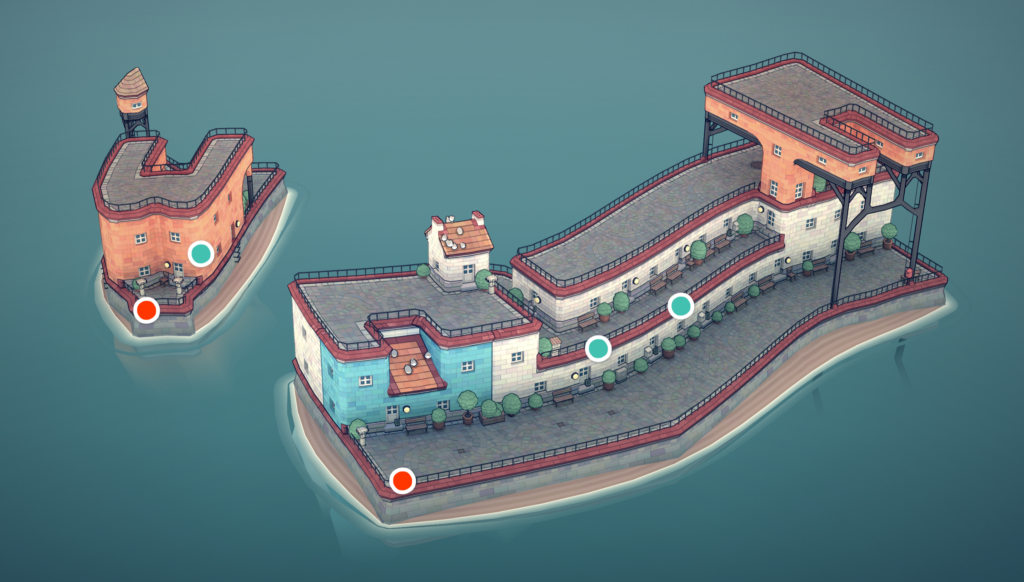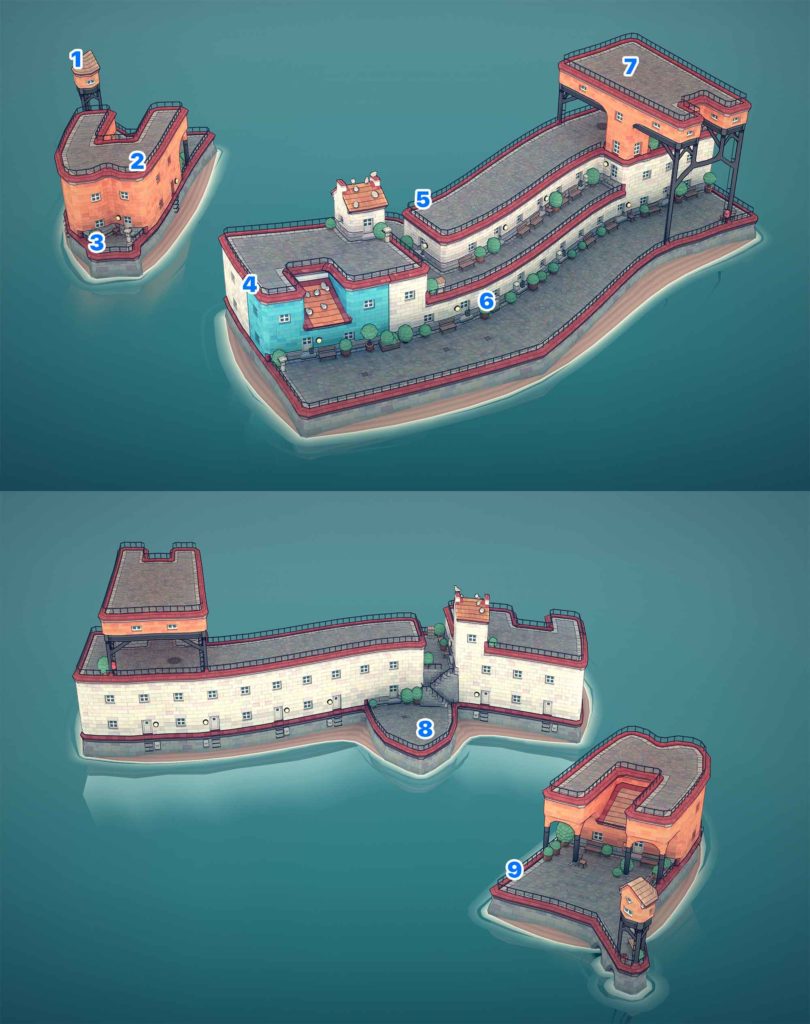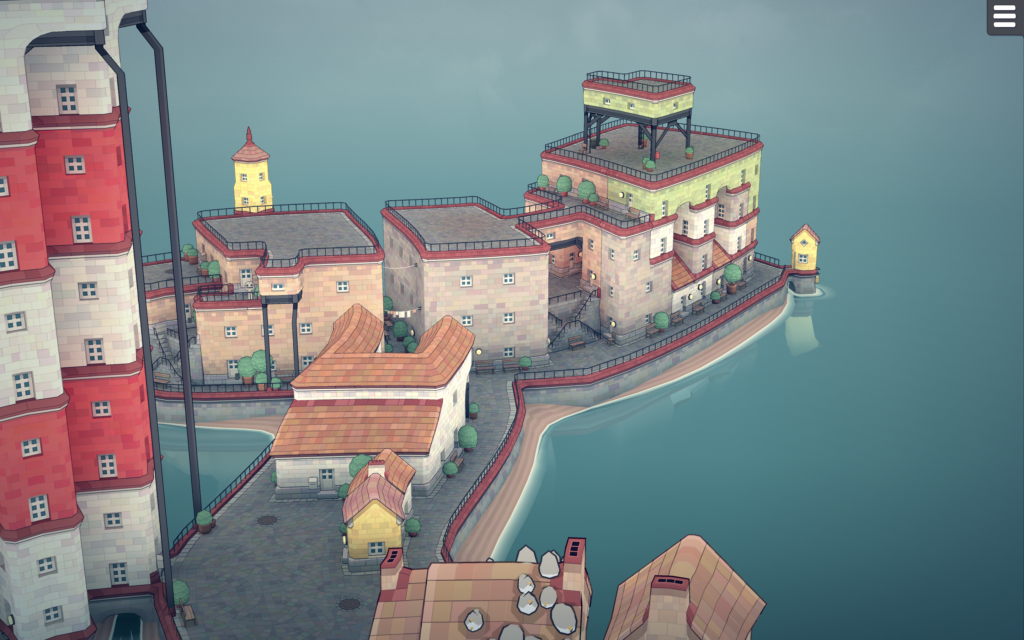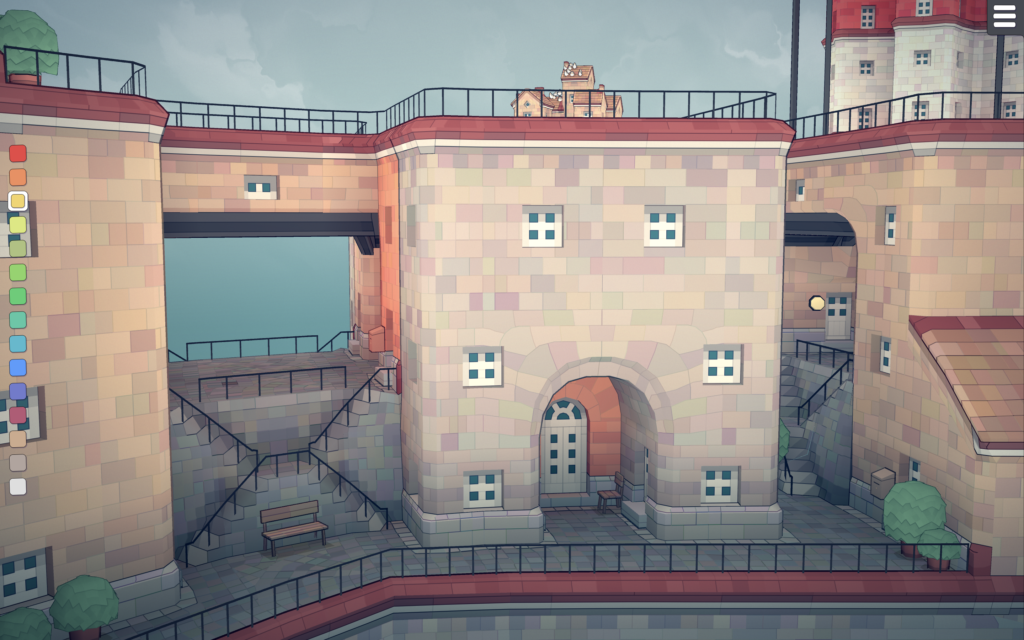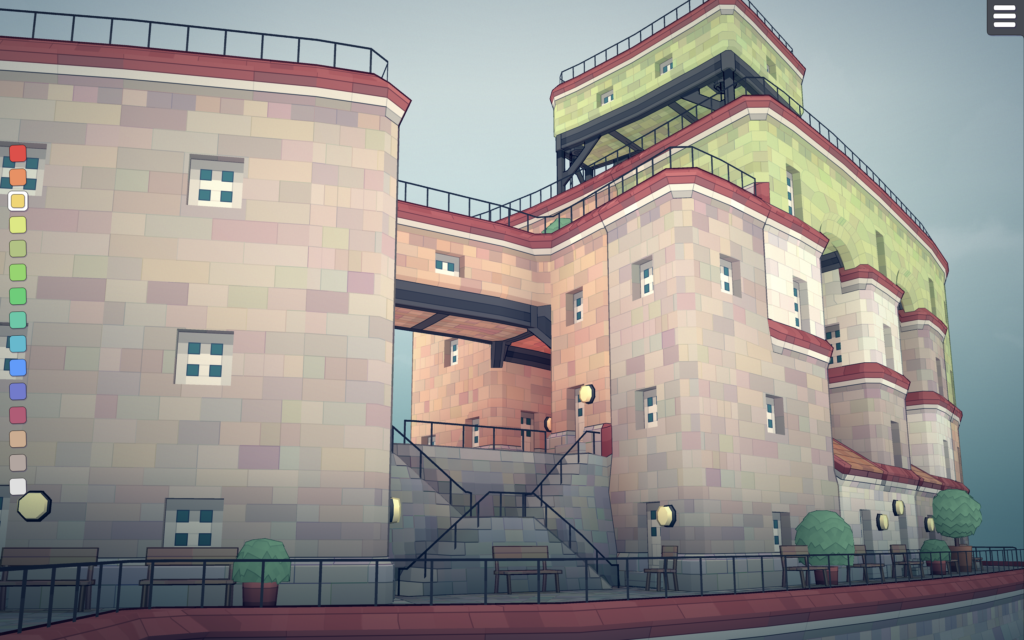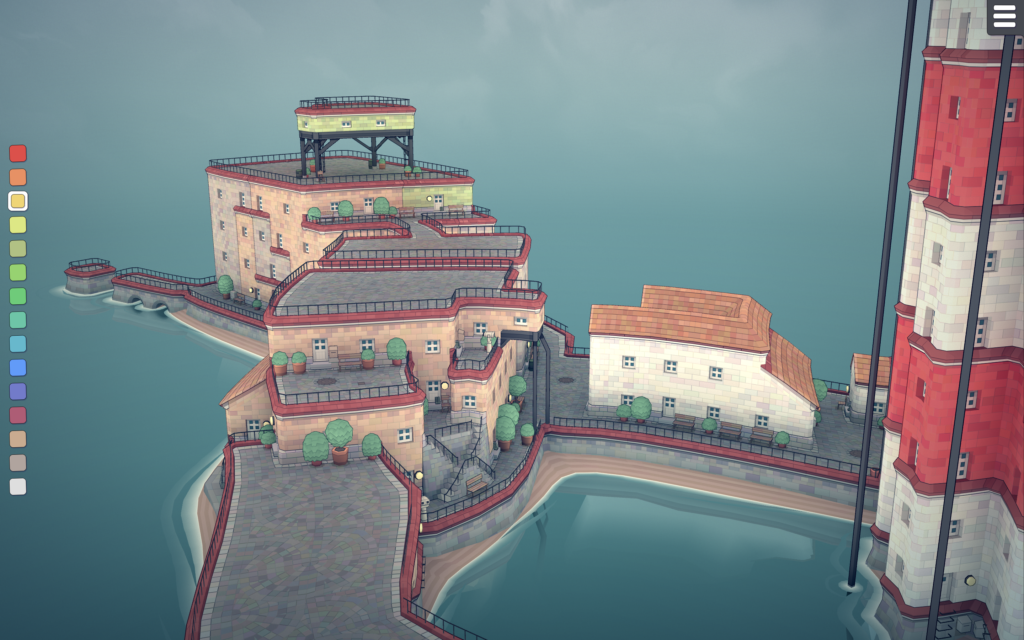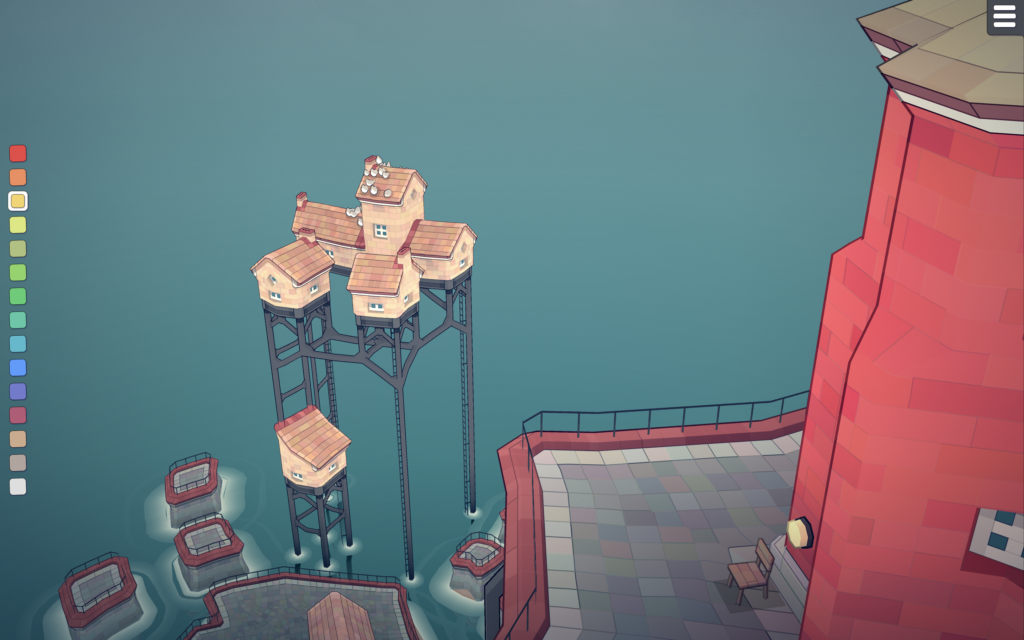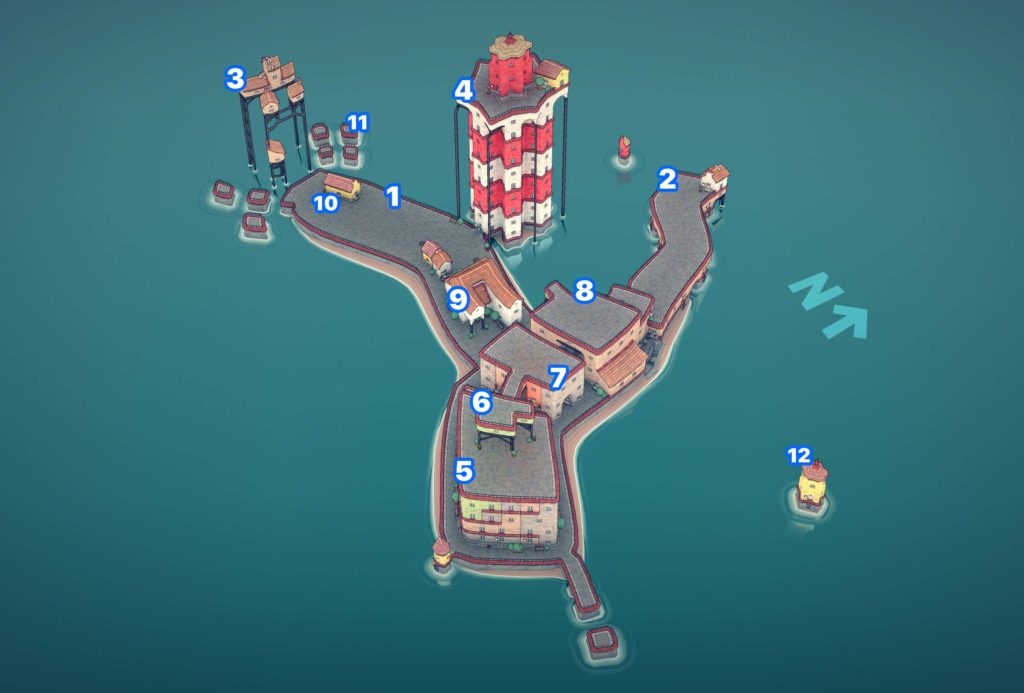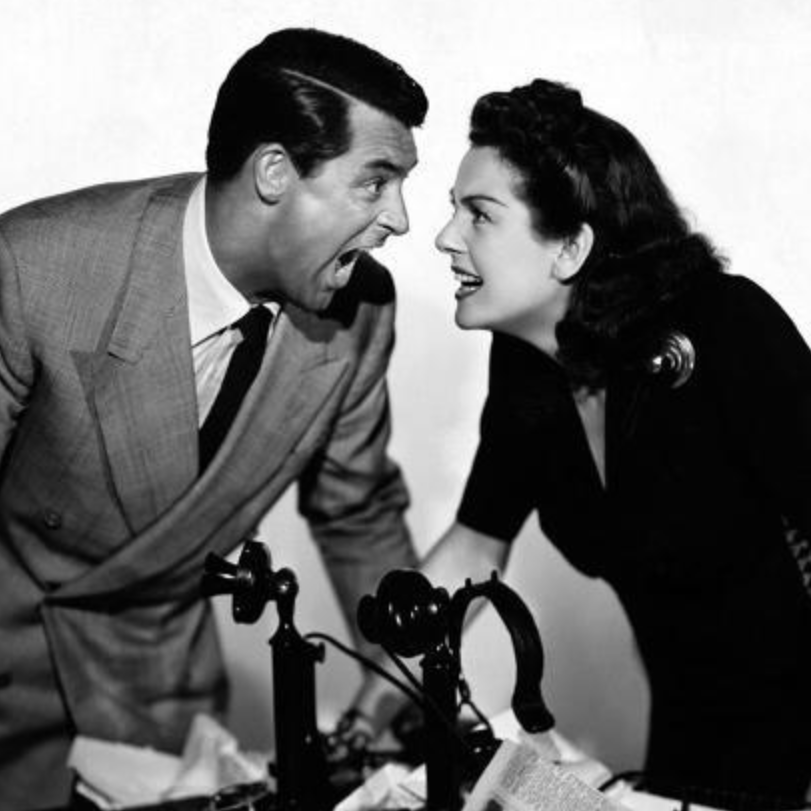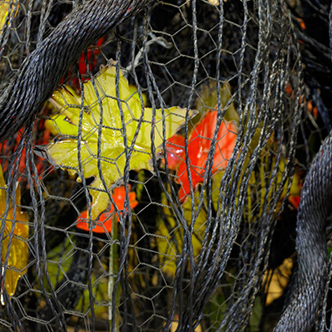Built in 1876, Hazard’s Spike is a Blyghe-style lighthouse intended to serve the outer reaches of Eyre Bay and guide ships to Porteroy City Harbor. The massive, three-sided lighthouse is constructed on the top of—and synonymous with—the shoal of Hazard’s Spike, a broad, rocky ridge on the outer skirts of Eyre Bay.
Blyghe lighthouses were a style of lighthouse developed by civil engineer Robert James Blyghe in 1855. Blyghe, who was former Chief Engineer for the City of Blackpool, had grown frustrated with the haphazard approach that he had perceived in the home-grown lighthouses popular in the day, and sought to design a lighthouse that would be modular, versatile, easily constructed, and perhaps even producable on scale.
While Blyghe’s goal was to make good lighthouses more accessible and ultimately save lives, his approach had some drawbacks. Blyghe houses are known to have numerous idiosyncrasies as a result of their low-cost, modular design, especially in their lamp-refueling and rotation mechanisms. Lighthouse operators complained that Blyghe systems were counter-intuitive and, ironically, required more training than the homegrown ones which, while they differed widely in some respects, were generally similar as far as operation. By the 1870s, Blyghe-style lighthouses were beginning to be referred to as “Blight-houses” and Blyghe’s ideas had fallen into disfavor.
As a result of that, many cities gradually replaced Blyghe houses over the next century. Only four Blyghe houses are known to be standing at this point.
For as long as there has been a harbor, Hazard’s Spike has presented a threat to traffic attempting to enter Porteroy Bay; ships have to navigate a narrow corridor with rocky shoals on both sides. While Hazard’s Spike was marked by an assortment of methods, including painted signs and signal lamps, it was still easily missed, especially in a storm. After the Glowworm wreck in 1862, the leaders of the nascent Porteroy City decided a lighthouse was necessary. Construction on Hazard’s Spike was begin in 1863 and completed in 1867.
The last and final keeper of Hazard’s Spike was Erskine Seed, a retired sea captain who had worked primarily as a jack-skipper: a for-contract freelance captain hired by various freight and transport firms at cheaper rates. A dour loner with a checkered employment history and a weakness for alcohol, Seed took the job in late 1948 after an unfulfilling part-time stint as a prospector, a job he disliked because it required what he considered to be excessive contact with people.
Records from Porteroy Municipal Bay Authorities, the operator of Hazard’s Spike, show that the then-director of the Signs & Signaling Unit, Earnest Czimanski, had his doubts about Erskine Seed, especially after learning that the former captain had lost a position with WTIC Shipping following an episode in which Seed—heavily drunk—reported being under attack by pirates when no such incident had taken place.
In a 1948 memo to the Hiring Committee, Czimanski commented that
“…I am aware that we have two other qualified candidates besides this man Seed; there is a merchant mariner of whom I have been provided exemplary remarks, and there’s that fellow Smithwick who used to command the Patrol post at St. Benjamin. Seed, I am hearing, is what some call a “good man in a storm” and others have described as a troubled shadow of the seaman he once was…Jack [probably John Horne, the operations manager for Southshore Transport] tells me there were mariners who passed up contracts when they heard Seed would be at the command. One fellow, at sea for twenty years, commented that he would not have considered Seed fit to pilot a life jacket, and that was not the only such remark of its kind…”
What Seed had in his favor was that, despite his dubious history, he was the only one of the candidates who had experience managing a Blyghe lighthouse. While stationed at Montale Bay Shipworks from 1938 to 1942, Seed had managed every aspect of the Montale Light, and earned high commendations from Harbormaster Steven Peele, who acknowledged that “…Erskine, like many of his age and career, is a man who enjoys a drink, but there is nothing like him when it comes to his tenacity or his resourcefulness…there was not a spot in Montale that saw darkness for more than thirty seconds [the period between flashes] when he was on watch, and I would suggest him to any such position without hesitation…”
Peele’s reference was one of the several received by PMBA, and despite Czimanski’s misgivings, Erskine Seed was offered, and accepted, the position of Municipal Chief Lighthouse Engineer on November 2, 1948.
On the night of June 4, 1950, the PMBA dispatch station at Ark Point received a broadcast from Seed asking why the support staff who normally brought him supplies had arrived several days early. This confused the radio operator, who had no record of any personnel being dispatched to the Spike. Seed claimed that a ship had just put in, expressed his hope that the visitors had remembered to bring him whisky—an item he was not allowed to request, but this prohibition seems to have been disregarded by friends on staff—and hung up.
Two hours later, Ark Point received an urgent broadcast from Seed stating that he was barricaded in his weather-room and under attack. Often unintelligible and less than coherent, Seed described a “wild crew” who had entered the Spike without identifying themselves, attempted to take control of the light and radio beacon, and brandished weapons when Seed made to stop them. The Ark Point radio operator on duty, a junior marine named Ilse Davek, attempted to calm Seed to the point that he could provide specific details, with little success:
SEED: “No, listen to me. Listen to me! These crazy sons of bitches. They came in from outside, and they’re in the ———, they’re all over the lighthouse! They won’t say ——— !!”
DAVEK: “How many men are there, Mr. Seed? How many men did you count?”
SEED: “…these fellows you sent…what the bloody hell did you send me here? They —— in the main docking area, and three of them ——— !!”
DAVEK: “…Mr. Seed. Mr. Seed, can you tell me how many there are? How many men are in the lighthouse right now?”
SEED: “They’re crazy sons of bitches! Crazy sons of bitches! I never ——— like it. The three of them ——— like they own the god damn place. One of them pointing the other two to get upstairs. I said, what do you ——— upstairs. Then the first one, he says nothing, but then he brings out a gun. A gun! Sons of bitches ———”
DAVEK: “Are there more than three men in the lighthouse right now, Mr. Seed? Three men?”
SEED: “Two of them, I don’t know where they are. They went upstairs. I don’t even —— men, but they act like men. There’s something wrong. It’s wrong. I don’t ——— about them. Never said nothing, just acted like they own the god damn place…”
Davek was haunted by the exchange and recalled later:
“…[Seed] was in quite a state, shouting and stammering. He sounded mad with fear. There was some static in the line, and he was hard to make out. At periods I heard a deep booming somewhere in the background, and it did not sound like line interference to me. The resonance suggested thunder, but it was not scattered like a thunderclap, nor did it trail off. I would have said it sounded more like an explosion, or some sort of gunfire…
He could hear it too, and he insisted it was an indication that [the invaders] were destroying parts of the lighthouse. He believed they had brought dynamite, and were attempting to raze the lighthouse for reasons that he did not know.
Now I had been told Mr. Seed’s history, and his predicament with drinking, and I have known many fine people who, when drunk, are seen to become unrecognizable…Of course the effects of alcohol cannot be underestimated, but I did not believe he was simply drunk and hallucinating anything. He sounded like a man who was in the fight of his life…”
Deeply concerned, Davek contacted the nearby Marine Patrol command to dispatch officers to the scene. MPC Ark Point, concerned about the worsening weather conditions, said that Seed sounded drunk and the idea of a raid on Hazard’s Spike was unfathomable; the explosions were dismissed as thunder. Nothing more was done that night.
When crew arrived at the island on the morning of June 6, Seed was nowhere to be seen. The lighthouse was still standing, and showed no signs of structural damage consistent with an attempt to destroy it. Marine Patrol staff noted that the emergency boats—two of them—were in their storage locker and did not appear to have been disturbed.
It was the outbuildings that showed the most damage. The storage shed for generator fuel had been leveled, likely the source of the explosions heard by Seed and Davek. Whether this was intentional is unclear. It was known that Seed had been cautioned at least twice for improper storage and maintenance; there had been several earlier incidents of spillage, and Seed’s failure to notice a faulty ventilation system had led to vapor buildup that inspectors described as “potentially disastrous”. What triggered the blast, however, was not known.
Marine Patrol staff were further perplexed to find burn marks and evidence of explosions on the upper deck of the loading dock. Sgt. Tom Corrigna, the chief investigator, did not believe these indicated an attempt to destroy the deck, stating that the burn patterns suggested the launch of a miniature rocket, possibly for use as a flare. Investigators also noticed what appeared to be a burn mark halfway up the second stage of the lighthouse, suggesting that a projectile had gone astray. No debris were found.
The radio room was severely damaged and showed signs of a struggle. Most of the furniture was smashed, with all storage bins thrown open. Several spare batteries had been shot numerous times; the radio cabinet itself had been wrenched open with what seemed to be brute force—there was no sign that tools had been used—and components had been torn out, seemingly hap-hazardly, and flung about the floor.
Local authorities recovered a torn scrap of dark green cloth, believed to be from a uniform, and small metallic projectiles that proved to be bullets of an unknown caliber. Blood was found on the stairwell.
But where was Seed?
Patrol crew
knocked on the door, and, receiving no response, assumed that Seed was incapacitated within, or perhaps dead. On opening the door, they were astonished to find no one in the room. No one had any idea how the door could have been secured, since the only other ways out of the room were a drain and a vent, neither of which was large enough to accommodate a person.
Some have suggested that Seed himself committed the damage—either through incompetence, or, in the case of the radio room, perhaps in a drunken rage. Coming to his senses, and aware that such a thing could destroy his already tainted career and invite legal problems, he invented the story of an attack on the island and then vanished to start over elsewhere. No explanation has been offered for the evidence recovered from the lighthouse, or Seed’s means of disappearing from the weather-room.
Erskine Seed was not seen again, and the Spike was closed shortly afterwards, rendered obsolete by
